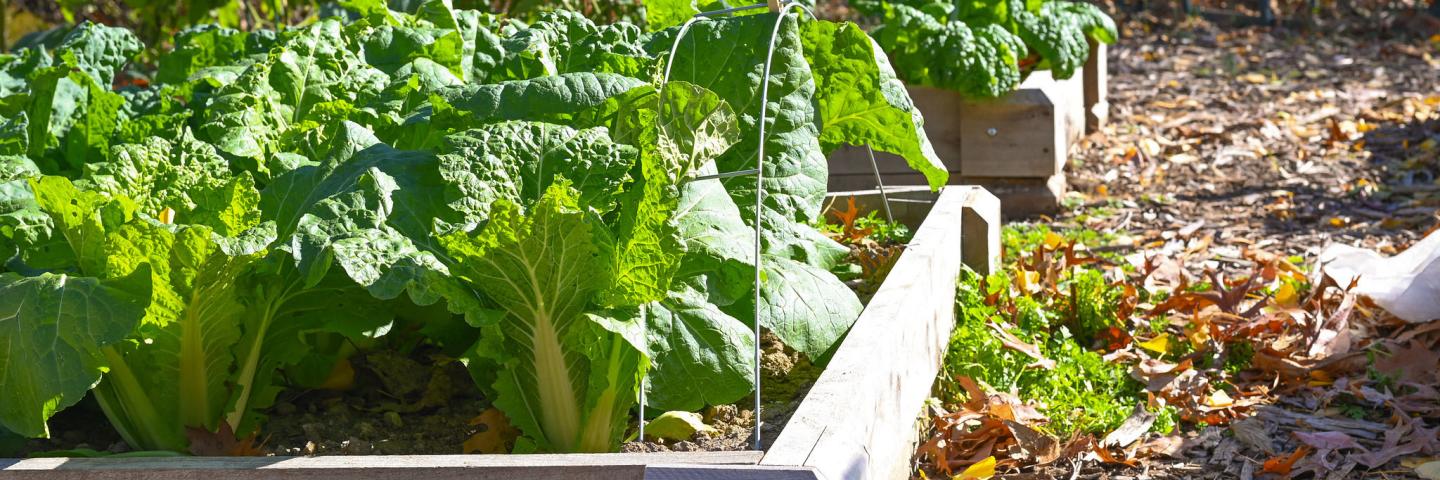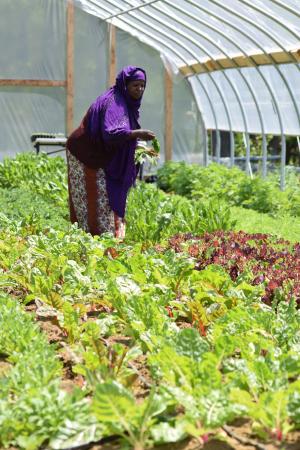Are you gardening or farming in an urban environment?

While many people might not consider Maine when they think of “urban agriculture,” there is assistance available for Mainers who are farming or gardening in our cities and suburbs.
BANGOR, Maine (May 3, 2023) -- From community gardens to indoor vertical farms, urban agriculture provides critical access to healthy food for local communities, as well as jobs, increased green spaces, and closer community ties. Urban agriculture includes the cultivation, processing, and distribution of agricultural products in urban and suburban areas. Community gardens, rooftop farms, hydroponic, aeroponic and aquaponic facilities, and vertical production, are all examples of urban agriculture. Tribal communities and small towns may also be included.
Urban agriculture does not have to be strictly in an "urban" or city setting like downtown Portland; small farms and producers that provide services to larger urban centers are eligible to participate in urban agriculture programs with USDA.
USDA can provide resources to start, expand, and operate your farm or garden, market what you grow, and help you recover in case of disaster.
From the Ground Up

Starting an urban farm comes with a unique set of challenges and opportunities, and the USDA’s Natural Resources Conservation Service (NRCS) helps farmers care for the natural resources on their land – soil, water, air, plants, and animals.
NRCS provides technical and financial assistance to growers in:
- Soil Health - As experts in soil health, NRCS conservationists can advise urban growers on what cover crops to grow, using farmers’ soil tests and our soil surveys.
- Irrigation and Water Conservation - We can help urban growers conserve water by assisting with things like drip irrigation.
- Weeds and Pests - We can help with pest and weed management by planting buffers for beneficial insects, through mulching, using cover crops and various other means.
- High Tunnels – NRCS can provide financial assistance for high tunnels, used to extend the growing season and to protect plants from harsh weather, air pollution and pests. By making local produce available for more months in the year, fewer resources are used to transport food to plates.
Innovative Ideas
Great ideas often start right in our communities, and USDA offers funding to help stimulate innovation to increase U.S. agricultural production while cutting the environmental footprint of our agricultural operations.
- Grants for Urban Agriculture and Innovative Production - Competitive grants initiate or expand efforts of farmers, gardeners, citizens, government officials, schools, and other stakeholders in urban areas and suburbs. Projects may target areas of food access; education; business and start-up costs for new farmers; and development of policies related to zoning and other needs of urban production.
- Cooperative Agreements for Compost and Food Waste Reduction - Cooperative agreements assist local and municipal governments with projects that develop and test strategies for planning and implementing municipal compost plans and food waste reduction plans. Implementation activities will increase access to compost for agricultural producers, improve soil quality and encourages innovative, scalable waste management plans that reduce and divert food waste from landfills.
Where Urban and Rural Meet
Some farms are not in big cities or rural areas but are in areas between the two. If that describes your farm or project, you may be eligible for programs from USDA’s Rural Development (RD). RD invests in rural America with loan, grant, and loan guarantee programs because we understand a strong community is rooted in its people. The commitment and resources we bring to rural communities helps drive economic security and prosperity. Our programs expand access to high-speed internet, electric, and transportation infrastructure, and support business growth, healthcare, education, housing, and other community essentials. We stand ready to be your partner in prosperity for rural America.
- Food Supply Chain Guaranteed Loan Program - Strengthens critical food supply chains and secures our food system through guaranteed loans of up to $40 million. Funds can be used to start or expand middle-of-the-food-supply-chain activities like aggregation, processing, manufacturing, storage, transportation, wholesale, or distribution of food. This program is open to lenders, including banks, credit unions, CDFIs, loan funds, and others to then make loans to for- or nonprofit businesses, cooperatives, federally recognized Tribes, government organizations, and food supply chain entrepreneurs. Lenders and projects can be located anywhere in the United States.
- Value-Added Producer Grants - Helps independent agricultural producers begin processing and marketing activities that add value to their products. Grant and matching funds can be used for planning activities, or for working capital expenses related to producing and marketing a value-added agricultural product. This program is open to independent producers, farmer and rancher cooperatives, producer groups, and majority-controlled, producer-based business ventures in any area.
- Rural Energy for America Program - Provides guaranteed loans and grants to eligible agricultural producers and rural small businesses to support renewable energy systems and make energy efficiency improvements. Funds also can be used to purchase energy-efficient agricultural production and processing systems. Grants can cover up to 40 percent of eligible project costs up to $250,000 for energy efficiency projects, and $500,000 for renewable energy projects. Loan guarantees are available for up to 75 percent of eligible project costs up to $25 million. Agricultural producers are eligible to apply without regard to population limits.
Economically and Environmentally Sound Agriculture

At www.farmers.gov/urban you can sign up to receive free farming guidance and information, explore resources available from the USDA’s Farm Service Agency (FSA) – including financial assistance and disaster support – and learn how to begin your working relationship with FSA.
FSA has several options for financial assistance:
- FSA’s Farm Loan Programs provide access to capital, either directly from FSA or through a third-party lender such as Farm Credit or your local bank. Farm Ownership Loans can help you purchase and improve land while Operating Loans can be used for shorter-term expenses such as fertilizer, labor, and equipment. Microloans of $50,000 or less are particularly beneficial for the unique needs of urban farms, offering reduced application and collateral requirements. Our youth loan program funds income producing agricultural projects of $5,000 or less for youth ages 10-20. FSA works with you to determine the best fit for the credit needs of your operation.
- FSA’s Farm Storage Facility Loan (FSFL) Program provides low-interest financing for producers to store, handle and/or transport eligible commodities they produce. Loan funds can be used to construct or upgrade new or used, portable or permanently affixed storage and handling facilities; purchase new or used storage and handling trucks; and/or purchase storage and handling equipment. A producer may borrow up to $500,000 per loan, with a minimum down payment of 15 percent. Loan terms are up to 12 years, depending on the amount of the loan.
- FSA also offers a suite of Disaster Assistance and Safety Net Programs designed to help farmers recover from and build resilience to natural disasters. These programs also provide and promote stability through fluctuating markets and prices.
- FSA’s Conservation Programs work to address farming and ranching related conservation issues including water protection, reducing soil erosion, preserving wildlife habitat, and protecting forests and wetlands.
Getting Started
You can meet face-to-face with staff at your local USDA Service Center to discuss your vision, goals, and ways USDA can help, or you can reach out to us by phone or email. There are 14 USDA Service Centers located throughout Maine where our specialists can offer options and strategies for implementing urban agriculture, and you can find out if it is the right fit for your operation.
USDA serves all agriculture – large to small, conventional to organic, rural to urban. As American agriculture continues to grow in new directions, USDA is growing along with it. By bringing opportunities to both rural and urban areas, we address many needs, including restoring the health of the soil and restoring the health of people.
###
USDA is an Equal Opportunity Provider, Employer and Lender

